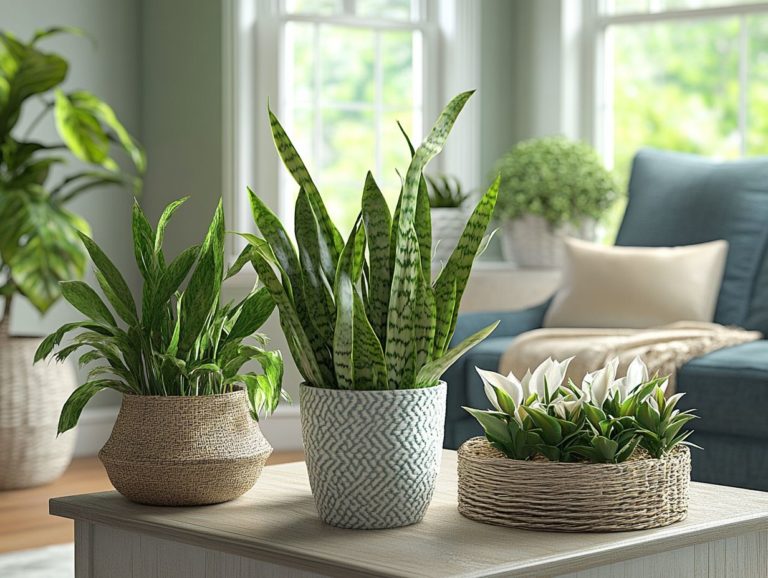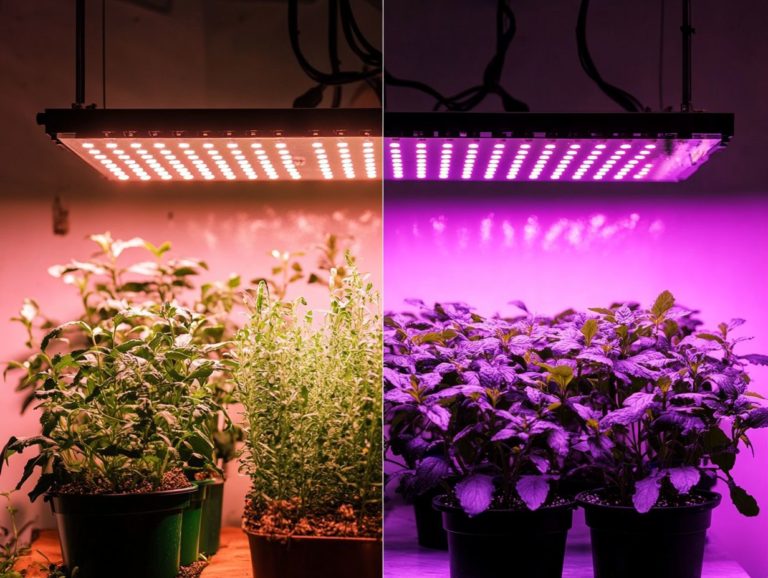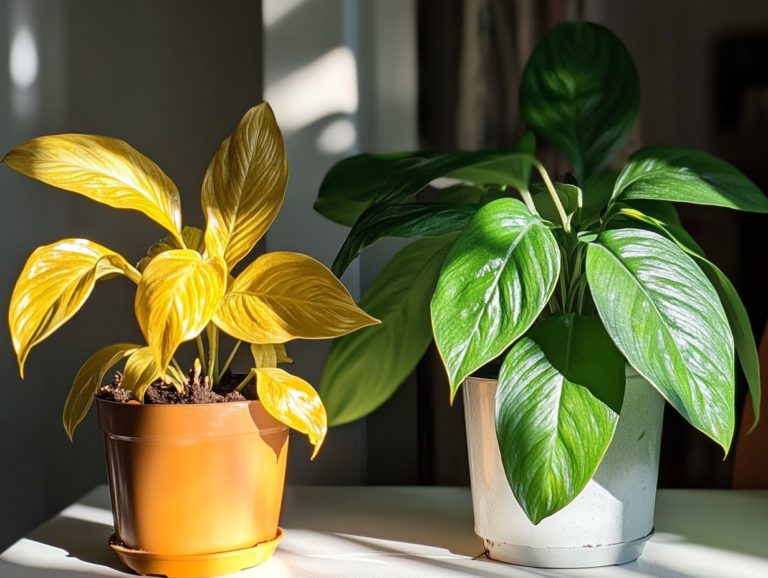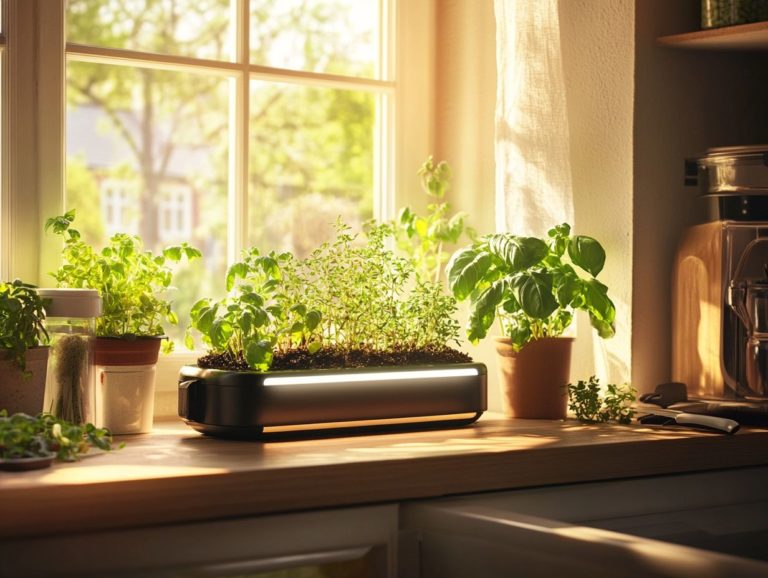Types of Grow Lights for Home Use
Choosing the right grow light can transform your home gardening journey. It enhances your indoor gardening experience.
With a plethora of options at your disposal, each type of grow light from LED to high-pressure sodium brings its own distinct advantages tailored to various plants and their lighting needs, ensuring optimal plant growth.
This article delves into 15 types of grow lights, highlighting their pros and cons, energy efficiency, and expert tips for optimal use, including their light characteristics and configurations.
Whether you re an experienced gardener or just dipping your toes into the world of indoor gardening, find the perfect grow light now to supercharge your gardening experience and improve your plant health.
Contents
- Key Takeaways:
- 1. LED Grow Lights
- 2. Fluorescent Grow Lights
- 3. High-Intensity Discharge (HID) Grow Lights
- 4. Incandescent Grow Lights
- 5. Plasma Grow Lights
- 6. Induction Grow Lights
- 7. Ceramic Metal Halide (CMH) Grow Lights
- 8. Light-Emitting Ceramic (LEC) Grow Lights
- 9. Light-Emitting Diode (LED) Grow Lights
- 10. Compact Fluorescent Lights (CFL) Grow Lights
- 11. High-Pressure Sodium (HPS) Grow Lights
- 12. Metal Halide (MH) Grow Lights
- 13. Dual Spectrum Grow Lights
- 14. Full Spectrum Grow Lights
- 15. Which Grow Light Is Best for Your Home?
- Frequently Asked Questions
- What are the different types of grow lights available for home use?
- What are the advantages of using LED grow lights for home gardening?
- Are fluorescent grow lights suitable for all types of plants?
- Can HID grow lights be used for a large indoor garden?
- Are incandescent grow lights recommended for home use?
- How do I choose the right type of grow light for my home garden?
Key Takeaways:
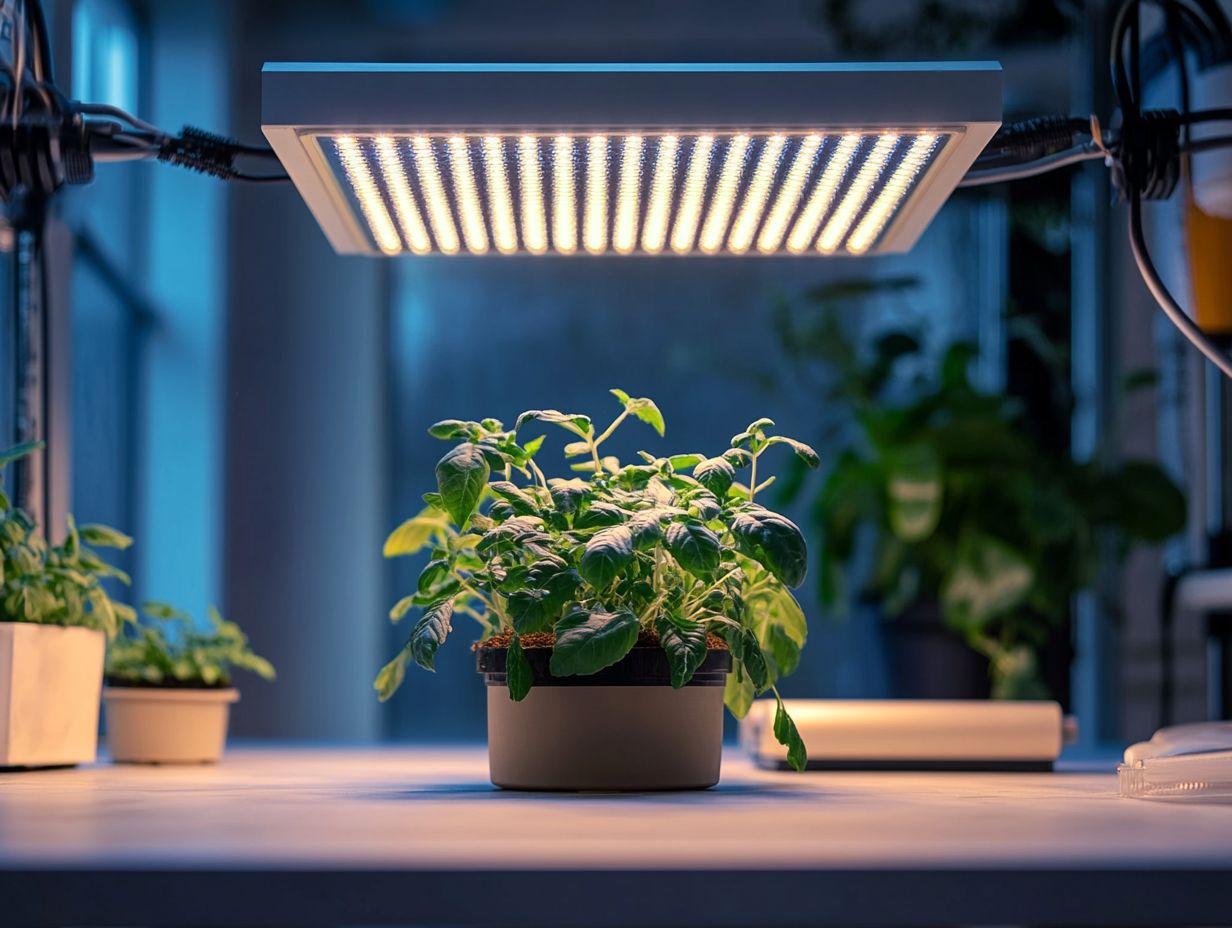
- LED grow lights are energy-efficient, utilizing advanced LED technology, and versatile, making them a popular choice for home use.
- Fluorescent grow lights are affordable and suitable for smaller plants, but may not provide enough light intensity for larger plants.
- High-Intensity Discharge (HID) grow lights have high intensity and are ideal for larger plants, but they can be expensive and require more energy consumption.
1. LED Grow Lights
LED grow lights have revolutionized the horticulture industry, offering you an energy-efficient way to elevate your indoor gardening game and improve your plant care routine. By delivering the optimal light spectrum for the photosynthesis process and chlorophyll absorption, these lights significantly enhance plant growth and health.
With a variety of configurations and light intensity options, they cater perfectly to the unique lighting needs of diverse plant varieties from vegetable seedlings to houseplants ensuring robust health and vitality.
One of the major advantages of LED grow lights is their low heat emission, which minimizes the risk of heat stress that can harm delicate plants, especially during critical seed germination, seedling, and flowering stages. Compared to traditional incandescent or fluorescent lights, which often waste energy and generate excessive heat, LED grow lights maintain ideal growing conditions and provide effective light placement with far less power consumption.
This efficiency leads to lower utility bills and gives you the power to create customizable light schedules tailored to your plants specific growth phases, enhancing your overall grow light usage. By adjusting both light duration and intensity, you can ensure your plants receive the precise wavelengths they need for optimal growth, making LED grow lights a critical tool in your modern horticultural toolkit and supporting effective urban farming practices.
2. Fluorescent Grow Lights
Fluorescent grow lights are your go-to solution for indoor gardening, offering a cost-effective and efficient way to boost plant health and growth, especially in hard-to-light spaces typical in urban farming environments.
These lights come in various types, with T5 and T8 being the most prominent, each boasting unique benefits in energy efficiency and light output, making them popular options in the horticulture industry. T5 fixtures shine bright with their higher lumen output per watt, providing a broad spectrum that supports a range of plants, from leafy greens to vibrant flowering species, making them ideal for various gardening tips and techniques.
On the other hand, T8 lights offer longevity and slightly lower energy consumption, making them perfect for gardeners who want to keep an eye on their budgets while optimizing their grow light options.
When you compare fluorescent grow lights to traditional incandescent lights or even modern LED options, you’ll find that they emit significantly less heat. This means there’s a reduced risk of overheating your precious plants while still maintaining the right light intensity for effective photosynthesis. With fluorescent grow lights, you can cultivate a thriving indoor garden without succumbing to excessive energy costs or heat damage, ensuring you meet your plants’ specific lighting needs.
3. High-Intensity Discharge (HID) Grow Lights
High-Intensity Discharge (HID) grow lights, including high-pressure sodium and metal halide, are known for their exceptional light intensity. They are the top choice for indoor gardeners aiming for robust plant growth and effective sunlight replacement.
These lights support every stage of your plants’ journey from the vegetative phase to the flowering period. They ensure optimal plant health. However, HID lights come with drawbacks, particularly regarding energy consumption and heat generation. This can impact your plant care routine.
Compared to alternatives like LED or fluorescent lights, HID systems require more power and generate considerable heat. Additional cooling measures will be necessary in your controlled environment.
Carefully weigh your specific needs. Balance the advantages of powerful lighting against the costs of energy consumption and the maintenance required to keep optimal temperature conditions for your indoor plants.
4. Incandescent Grow Lights
Incandescent grow lights may not be the most efficient option, but they can still play a valuable role in your plant care routine. They provide warmth and light, especially during the crucial early stages of seed germination and initial plant development.
These lights emit a warmer spectrum that encourages early growth, making them appealing for nurturing seedlings and promoting successful plant therapy. However, their energy consumption is higher compared to LED or fluorescent lights, so watch out as your electricity bills can rise!
When it comes to durability and lifespan, fluorescent lights and LEDs clearly outperform incandescent options. The heat produced by incandescent lights might be beneficial in certain situations, but the long-term advantages of LEDs and fluorescents like lower energy usage and a broader light spectrum make them the preferred choice for most indoor gardening scenarios.
5. Plasma Grow Lights
Plasma grow lights represent a remarkable leap in indoor gardening technology. They provide a full spectrum of light that closely imitates natural sunlight, supporting optimal plant growth while ensuring impressive energy efficiency.
These lights are crafted to deliver a balanced spectrum ideal for the plant food-making process. They are particularly effective for a diverse array of plants from leafy greens to vibrant flowering varieties.
Their impressive longevity reduces replacement costs, allowing you, as an urban farmer, to invest in sustainable practices without the hassle of frequent light changes.
Operating at cooler temperatures, plasma lights create superior growth conditions in controlled environments like greenhouses and vertical farms. This promotes efficient urban farming strategies. Their adaptability enhances the health of individual plants while supporting efficient urban farming strategies in limited spaces.
Which grow light will boost your plants’ growth today?
6. Induction Grow Lights
Induction grow lights represent a cutting-edge advancement in the gardening world. They are prized for their remarkable energy efficiency and impressive lifespan, making them a sustainable choice for plant care in controlled environments.
Unlike traditional lighting options, these lights harness a type of energy that can create light to generate illumination. This means they produce minimal heat and consume less energy, which is ideal for energy-conscious gardeners. This also helps lower your electricity bills while maintaining a more stable temperature for your plants crucial for effective plant lighting.
Induction lighting is especially advantageous for indoor gardening. A diverse range of plants from leafy greens to vibrant flowering species requires consistent and tailored lighting conditions to thrive and promote effective photosynthesis, the process plants use to convert light into energy. Their ability to support the photosynthesis process addresses the unique light spectrum needs of different plant varieties, ensuring optimal growth and robust health for your indoor plants.
7. Ceramic Metal Halide (CMH) Grow Lights

Ceramic Metal Halide (CMH) grow lights are truly a game changer. They offer you a near full spectrum of light that significantly enhances plant health and growth. With these lights, you can transform your indoor garden with light that rivals natural sunlight.
What sets CMH lights apart is their balanced spectrum that closely mimics daylight. This makes them incredibly effective for all stages of plant development, from germination to flowering, and supports various light types. Unlike traditional fluorescent or high-pressure sodium lights, CMH fixtures generate less heat and boast higher energy efficiency, which translates to lower energy costs while supporting robust growth and effective photosynthesis.
Their capacity to produce a wide range of wavelengths not only benefits typical horticultural practices but also opens doors for innovative techniques like plant therapy. Specific light spectrums can enhance plant resilience and therapeutic qualities, ensuring that your plant varieties thrive under optimal conditions. With such versatility and efficiency, it s no wonder that many gardening enthusiasts are embracing CMH lights as a superior choice in modern horticulture and indoor gardening.
8. Light-Emitting Ceramic (LEC) Grow Lights
Light-Emitting Ceramic (LEC) grow lights offer you an innovative solution. This technology beautifully marries ceramic materials with cutting-edge lighting efficiency, delivering the full spectrum of light essential for thriving plant growth and health in your indoor gardening space.
This sophisticated lighting method harnesses a unique blend of materials, allowing it to emit light far more efficiently than traditional fluorescent or HID systems. The result? Lower energy consumption and reduced heat output. You ll find that these lights not only trim down your electricity bills but also create optimal growth conditions by providing a balanced spectrum that closely resembles natural sunlight.
With the ability to penetrate deeper into the plant canopy, LEC lights are rapidly transforming into a must-have for indoor gardeners. They empower you to achieve higher yields and cultivate healthier plants all while saving precious space. As technology continues to advance, embracing these lights positions you at the forefront of sustainable gardening practices.
9. Light-Emitting Diode (LED) Grow Lights
LED grow lights are changing the game for indoor gardening enthusiasts! They are celebrated for their impressive energy efficiency and customizable light intensity. These lights have a remarkable ability to support the process plants use to turn light into food across a wide range of plant varieties.
These advanced lighting systems harness advanced materials that help produce light efficiently to emit specific wavelengths tailored to meet the diverse needs of your plants. This fosters robust growth and vibrant blooms. Unlike traditional incandescent or fluorescent bulbs, LED options are designed to consume significantly less energy, often slashing your electricity bills by up to 50%.
You can easily configure these lights to cater to different growth stages be it vegetative or flowering phases ensuring your plants receive the optimal light intensity they crave. This versatility amplifies overall growth and cultivates healthier yields, making LED grow lights a sustainable choice for both the budding gardener and the seasoned professional.
10. Compact Fluorescent Lights (CFL) Grow Lights
Compact Fluorescent Lights (CFL) are an exceptional and cost-effective choice for your indoor plants! They deliver ample light for growth while consuming significantly less energy than traditional incandescent bulbs.
This makes them particularly attractive for indoor gardening enthusiasts like you, who value both performance and energy efficiency. CFLs emit a well-balanced light spectrum that fosters healthy photosynthesis, essential for seed germination and the overall development of your plants.
When you position CFLs strategically, you can place them close to your seedlings, ensuring optimal light exposure without the risk of overheating. Unlike other grow light options such as high-intensity discharge (HID) lights or light-emitting diodes (LEDs), CFLs produce less heat, minimizing the potential for damage to your delicate young plants.
Their compact design also provides you with the flexibility needed to fit them into smaller indoor spaces, making them a versatile choice for any gardener aiming for success.
11. High-Pressure Sodium (HPS) Grow Lights
High-Pressure Sodium (HPS) grow lights are celebrated for their remarkable light intensity and their ability to accelerate flower production. They are an essential tool in the horticulture industry, particularly for ornamental and fruiting plants.
Their unique spectrum, abundant in red and orange wavelengths, specifically supports the flowering stage, promoting the growth of vibrant blooms and bountiful fruits. However, while HPS lights shine in terms of effectiveness, they also come with notable drawbacks.
For instance, their energy consumption can significantly surpass that of newer technologies like LED lights, leading to higher electricity costs over time. Also, the heat generated by HPS lights may require additional cooling systems, further straining both your budget and resources.
It s crucial for growers to weigh these factors carefully to fine-tune their cultivation practices for optimal results. Consider upgrading to HPS lights today for a flourishing garden!
12. Metal Halide (MH) Grow Lights
Metal Halide (MH) grow lights are your best bet for creating an optimal environment for your plants! Their broad light spectrum closely mimics natural sunlight, making them essential during the vegetative phase of growth perfect for both houseplants and vegetable seedlings.
These lights emit a harmonious blend of blue and white wavelengths, promoting robust leaf development and overall vitality for your plants. When you stack them against other options like High-Pressure Sodium (HPS) and LED lights, MH lights stand out for their energy efficiency.
They deliver impressive output without cranking up the heat, making them ideal for indoor gardens where maintaining temperature is key. While HPS lights shine during the flowering phase, the full-spectrum capabilities of MH lights are invaluable in those early stages of growth.
This ultimately leads to healthy, strong plants that are ready to thrive in the next phase of their journey.
13. Dual Spectrum Grow Lights
Dual spectrum grow lights offer you a perfect blend of blue and red light wavelengths. This creates an ideal environment for both vegetative growth and flowering, making them an exceptionally versatile choice for your indoor garden.
These lights mimic natural sunlight, allowing your plants to flourish throughout their entire growth cycles. The blue light is particularly important, as it supports the important parts of how plants make food, promoting vibrant, leafy growth in the early phases.
On the other hand, the red light spectrum is crucial for blooming and fruiting. It provides the extra boost needed during flowering periods. By addressing the specific needs at each stage of growth, dual spectrum lights significantly enhance your plants health, vigor, and yield, whether you’re cultivating leafy greens or vibrant flowering species.
With these lights, every aspect of the growth process is expertly supported. Watch your plants thrive with the right light!
14. Full Spectrum Grow Lights

Full spectrum grow lights present a comprehensive array of light wavelengths that closely mimic natural sunlight. This is essential for maximizing photosynthesis and fostering overall plant growth and health.
These lights are tailored to meet the diverse requirements of plants at different growth stages. From seedlings that benefit from softer blue hues to mature plants that flourish under more intense red spectrums, they adapt seamlessly to your gardening needs.
The versatility of full spectrum lighting allows it to support flowering, fruiting, and vegetative growth. It’s ideal for indoor gardeners who want to replicate the ebb and flow of the changing seasons!
Unlike traditional grow lights, such as fluorescent or narrow-spectrum LEDs, full spectrum lights offer a well-rounded approach that encourages vibrant, healthy plants. Their remarkable efficiency in mimicking sunlight not only accelerates growth rates but enhances the quality and yield of your produce. These lights are a critical asset for any horticulturist.
15. Which Grow Light Is Best for Your Home?
Choosing the best grow light for your home hinges on several factors, including the types of plants you’re nurturing, their specific lighting needs, and the space you have available for optimal light placement in your indoor gardening setup.
For example, houseplants like snake plants or pothos thrive with less intense light. Meanwhile, seedlings crave strong, direct illumination to fuel their healthy growth. It’s also crucial to consider the light spectrum. Full-spectrum lights are your best bet for all growth stages, although some plants may flourish with red or blue wavelengths during specific times.
Positioning your lights at the right heights is key to ensuring even distribution, which enhances growth without the risk of leaf burn. Opting for energy-efficient LED options will help keep those electricity bills in check. Don t forget to adjust your light durations! Providing about 12 to 16 hours of light for seedlings while offering a bit less for mature plants will help keep everything thriving.
What Are the Differences Between These Types of Grow Lights?
Understanding the distinctions among various types of grow lights, such as LED, fluorescent, and HID (High-Intensity Discharge), is crucial for optimizing your plant growth and creating the ideal conditions for thriving indoor gardening.
Choosing the right lighting not only affects the vibrancy and health of your plants but also plays a significant role in your energy consumption and overall gardening costs. LEDs are particularly impressive due to their exceptional energy efficiency and ability to deliver a full light spectrum. They are perfect for a diverse array of plants, including succulents and flowering species.
Fluorescent lights, on the other hand, are often preferred for seedlings. They emit a softer light that promotes initial growth, though they might struggle to penetrate denser foliage. Meanwhile, HID lights are typically reserved for larger setups, providing high-intensity output that’s well-suited for heavy feeders like tomatoes.
Grasping these nuances will give you the power to make informed choices that cater to the specific needs of your green companions, ensuring a flourishing indoor garden!
Which Type of Grow Light Is Most Energy-Efficient?
When evaluating energy efficiency among grow lights, LED technology stands out as the clear leader. It offers significant reductions in energy use while providing the best light for your plants growth.
Unlike traditional fluorescent or HID lights, which use a lot of energy and create unnecessary heat, LEDs operate at a lower wattage. You ll see lower utility bills over time, making them a great choice for indoor gardening enthusiasts who want to maximize yields without overspending.
While fluorescent lights may provide decent illumination, their shorter lifespan compared to LEDs means you ll have to replace them more often, leading to extra costs. Similarly, HID lights, despite their power, need a hefty energy input and require more cooling systems to manage their heat output.
Choosing energy-efficient LED lights not only improves your growing environment but also saves you money in the long run!
What Are the Pros and Cons of Each Type of Grow Light?
Each type of grow light has its own distinct set of advantages and drawbacks, affecting their effectiveness for different indoor gardening needs and influencing your plants health and growth.
Understanding these details is essential for anyone eager to cultivate a flourishing indoor garden, whether it s filled with stunning ornamental plants or a delightful collection of edible herbs. Some lights are specifically designed to emit a spectrum ideal for seedling development, while others shine when promoting flowering.
Factors like energy consumption and heat output are crucial for the long-term suitability of your chosen grow light. Excessive heat can stress your plants, and high energy bills can impact your budget.
By carefully assessing these factors, you can choose grow lights that perfectly fit your needs, creating the optimal environment for your green companions to thrive.
How Do You Determine the Right Size of Grow Light for Your Space?
Finding the ideal size of grow light for your gardening space requires evaluating the area s dimensions, the types of plants you re nurturing, and their specific light placement needs for optimal growth.
Understanding the unique needs of different plant species is essential; some thrive under higher light intensity, while others prefer a more gentle environment. The dimensions of your room significantly affect the effectiveness of light coverage. In larger spaces, you may find that multiple fixtures or higher wattage are necessary to illuminate the area adequately.
As a general rule, use about 20-40 watts per square foot of growing space, adjusting based on your plants’ light needs. Keeping these factors in mind will help you arrange your lights for the best possible outcome in your garden.
What Are Some Tips for Using Grow Lights in a Home Setting?
Using grow lights effectively in your home requires attention to detail. It s crucial to know your plants’ specific light needs, adjust the duration of exposure, and ensure that the lights are positioned correctly for their growth.
For instance, different plant varieties have unique requirements; some thrive under intense light, while others do better in a more gentle glow. Adjusting the distance of the light source can make a significant difference.
Monitor your energy consumption. Efficient use of grow lights not only nurtures your plants but also keeps your electricity bills in check. Schedule light duration to mimic natural sunlight cycles, which can significantly promote healthier growth. Typically, most indoor plants do best with about 12 to 16 hours of light each day, followed by a restful period of darkness.
Frequently Asked Questions
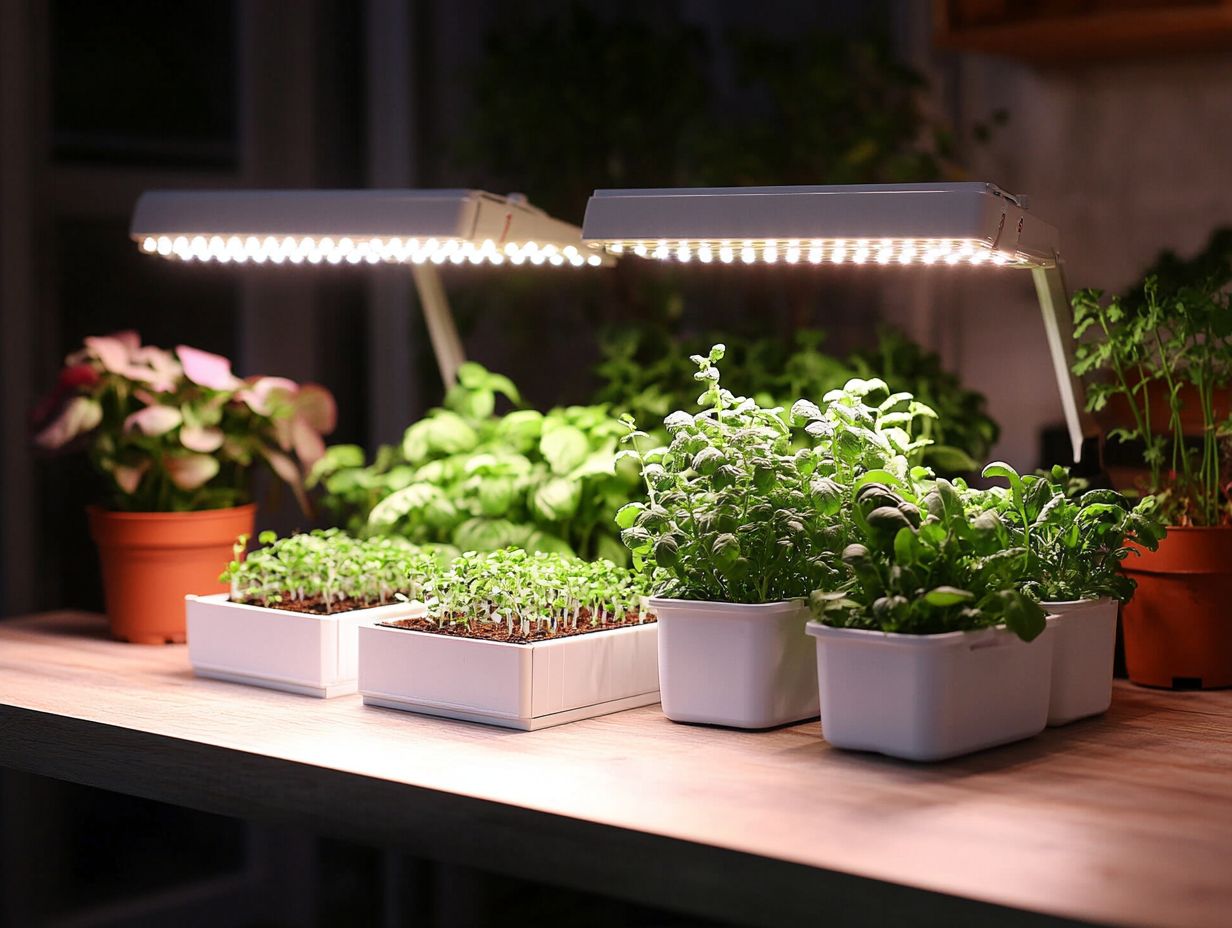
What are the different types of grow lights available for home use?
There are several types of grow lights that can be used for growing plants at home, including LED, fluorescent, HID, and incandescent lights.
What are the advantages of using LED grow lights for home gardening?
LED grow lights are energy-efficient and generate less heat. They last longer and can emit specific wavelengths, making them perfect for home gardening.
Are fluorescent grow lights suitable for all types of plants?
Fluorescent lights work well for low to medium light plants like herbs and leafy greens. However, they may not provide enough intensity for high-light plants such as vegetables and flowering species.
Can HID grow lights be used for a large indoor garden?
Yes, high-intensity discharge (HID) lights are excellent for large indoor gardens. They produce high light intensity but also generate excess heat, so a cooling system may be necessary.
Are incandescent grow lights recommended for home use?
No, incandescent lights are not ideal for home use. They generate a lot of heat, consume much energy, and have low light intensity, making them unsuitable for most plants.
How do I choose the right type of grow light for my home garden?
Choosing the right grow light depends on your plants, garden size, and budget. Research and consult with experts to find the best option for your needs.


